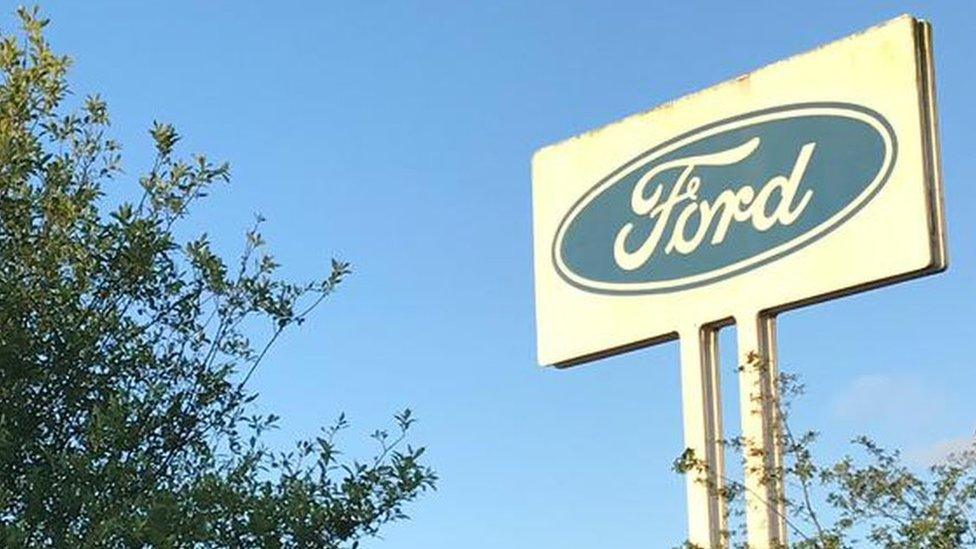Bridgend and the M4: How the motorway shaped the town
- Published
M4 in Wales - the rocky road building it in 1976
If there's anywhere that typifies the M4 corridor it's Bridgend.
The halfway town between Cardiff and Swansea, the motorway has defined how it has grown in the last 40 years.
A cluster of big businesses, led by the likes of Ford and Sony, grew up around Bridgend in the 1970s and early 1980s. The community is now reeling from the news that Ford is to close its engine plant - which has employed more than 1,700 people for nearly 40 years.
That relationship with the car then has a particular significance.

A bumpy road building the M4
The motorway into Wales didn't just suddenly appear. What might appear pretty seamless today took 30 years to finally join up a series of stop-start road projects.
It's helpful to see the M4 in Wales as a series of bypasses for the old A48, which were built in sections and evolved from just the old Severn bridge and Port Talbot bypass in 1966.
By the mid-1970s, it was costing £3.5m a mile to build and Bridgend had to wait its turn due to economic cutbacks.
There was already frustration that the new road was two lanes in places - not three. And cost-cutting meant there were no services along the whole of the motorway in Wales to start with either. That's why all services now are off roundabouts at M4 junctions in Wales.
It was 1981 before the section between junctions 35 and 37 finally opened.
Since then, modern housing estates have grown up in Bridgend's districts - a commuter belt.
As a final touch, by the end of the 1990s, the McArthur Glen retail park was a major draw with 90 out-of-town shops just off junction 36.
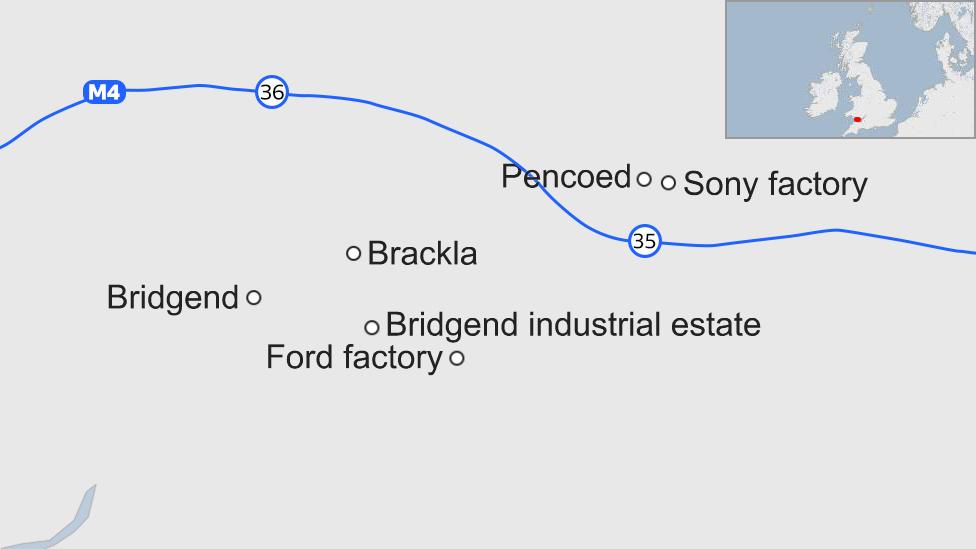
So does the M4 still have a pull?
More than 17,000 people still commute into the Bridgend area to work every day - this is at least a third more than 15 years ago
Its population has also been the second-fastest growing in Wales outside Cardiff - and is expected to top 150,000 by 203
The wider county boasts 4,600 different workplaces, 20 with businesses of more than 250 workers. The Bridgend Business Forum has more than 850 members
Bridgend has continued to grow, with dozens of suppliers and more recently tech and life sciences companies attracted to nearly 30 business parks, off two motorway junctions.
Big employers near the M4 junctions
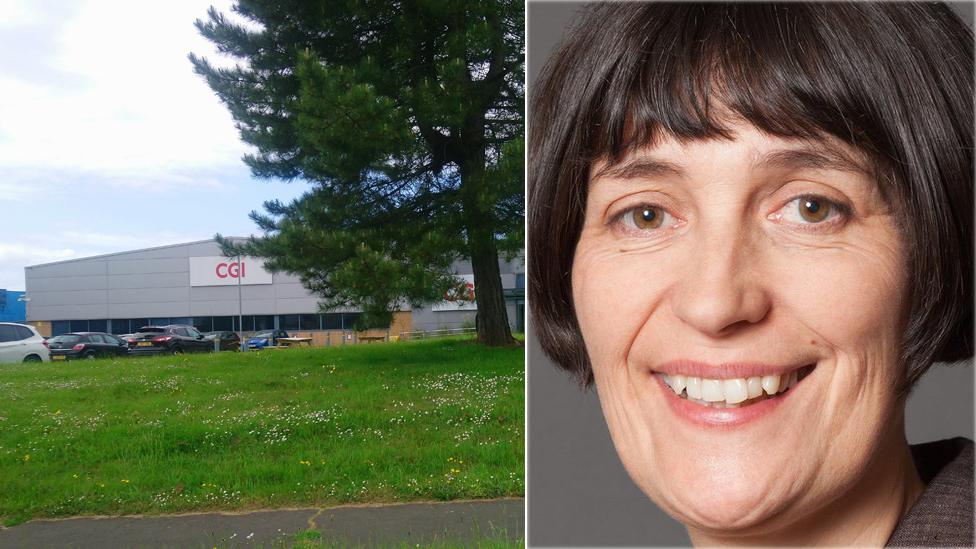
Tara McGeehan, president of CGI, which has three offices in Bridgend
One of the town's biggest employers now is IT services and cyber security company CGI, which has 1,200 workers at three different sites.
As an indicator of commuter patterns, 41% of the workforce live locally, a third come from Cardiff and the Vale area, 17% come from Swansea and just under 10% come from Newport or over the border in England.
UK president Tara McGeehan said locations near to the M4 were a "contributory factor but not the driving factor" for choosing Bridgend - it was also the proximity to universities, a workforce as well as the infrastructure.
Ms McGeehan herself finds cross-country train travel into Wales can be frustrating - taking three changes and at least five hours between her home in Nottinghamshire to reach the Bridgend bases.
"I drive largely when I come to Wales - it's just too difficult to get to Bridgend on the train, it takes all day to do that but it takes about three hours in my car," she said,
Working in the centre
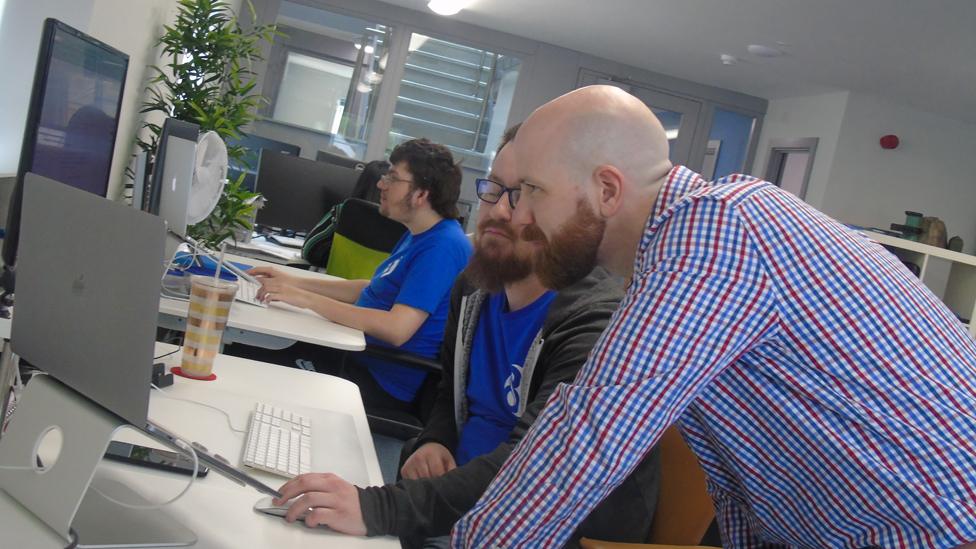
Dave Williamson (right) of software and web firm Team 8, which is committed to Bridgend town centre
The town centre is four miles from the motorway.
It is a story that could be told up and down the country. Shops and other businesses face wider economic challenges - as well as the blow of the Ford closure. And then there is the pull of out-of-town shopping, Cardiff and online retail.
Team 8 Digital are new software and website consultants, who won best start-up at the Bridgend Business Awards.
Two of the directors have strong Bridgend links and decided to base the business in the town centre.
General manager Dave Williamson, 31, said travelling to and from the office was relatively easy by both car and train for the workforce.
"Congestion getting into Bridgend isn't really a huge issue, it's a generic town in terms of the volume, it's certainly not like Cardiff levels," he added.
He himself uses the train and has been been "shocked how regular and punctual" they have been.
"Compared to what I was paying in London for a zone 1 and 2 travelcard, trains here cost me £100 a month, which is nothing," he added.
"By car, parking would cost me £23 a week for a season ticket, and then there's fuel and maintenance cost. So I think the public transport side of things is actually quite good for Bridgend - ask me about Cardiff and that's another story!"
Revitalising the town centre
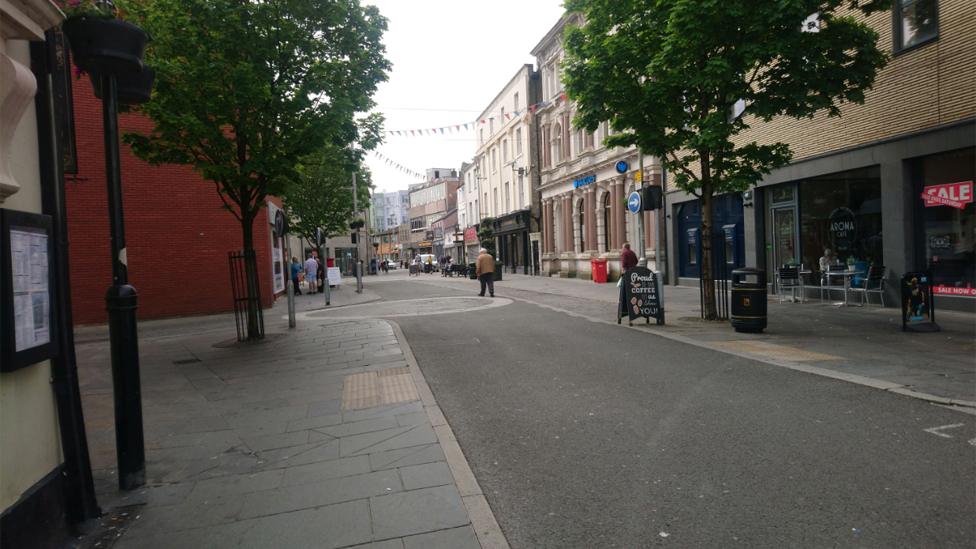
Bridgend town centre is currently pedestrianised - but there are moves to change this
Bridgend's challenge seems to be overcoming a negative image of its town centre - and persuading the people who live and work there to use it more.
The town centre is a business improvement district (BID) - called CF31 - an umbrella for 389 shops, pubs, restaurants and other enterprises, who each pay a contribution.
There are events like a food fair and forthcoming wartime heritage day, a regular street market - which had 29 stalls last month - and 68 businesses so far have also signed up to a Bridgend gift card, which is trying to encourage people to spend locally.
There are hopes that in the future more short-term parking can be provided, and de-pedestrianisation in the lower end of the town to give people easier access to shops.
The council meanwhile has a fund to improve the frontages of local shops as part of regeneration., external
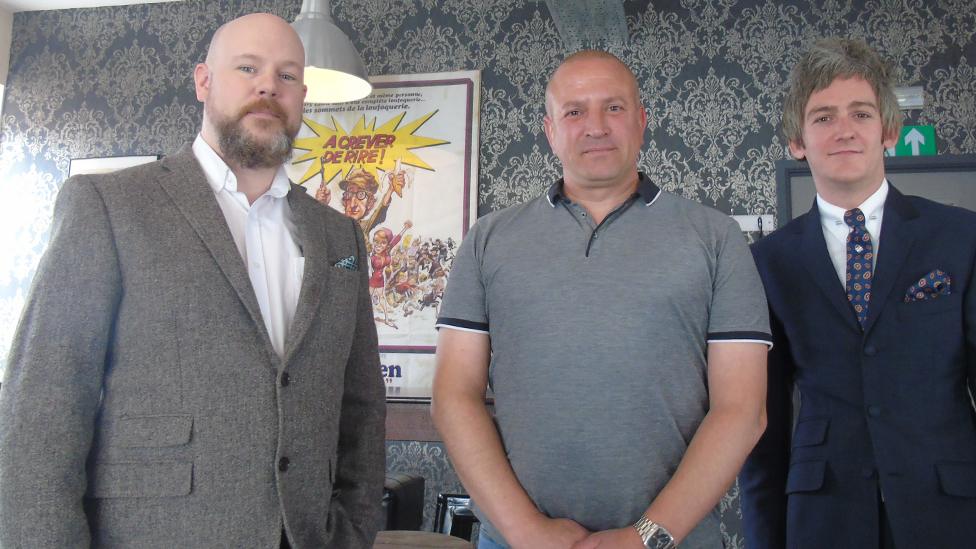
Local business people are driving the the Bridgend business improvement district - Stuart Shawcroft, Justin Jenkins (BID manager) and Alex Kilby
Justin Jenkins, a trader in the town for more than 20 years, now runs CF31. He said they were working hard on reversing some of the negative perceptions - and improving the shopping experience, especially for younger people going forward.
"No one element will fix it - it's about improving access, reducing some of the anti-social behaviour and marketing the town centre better," he added.
"The Bridgend card was a slow burner to start with but it's a Bridgend currency, if you like."

New homes are still in demand in Bridgend - especially those close to the M4
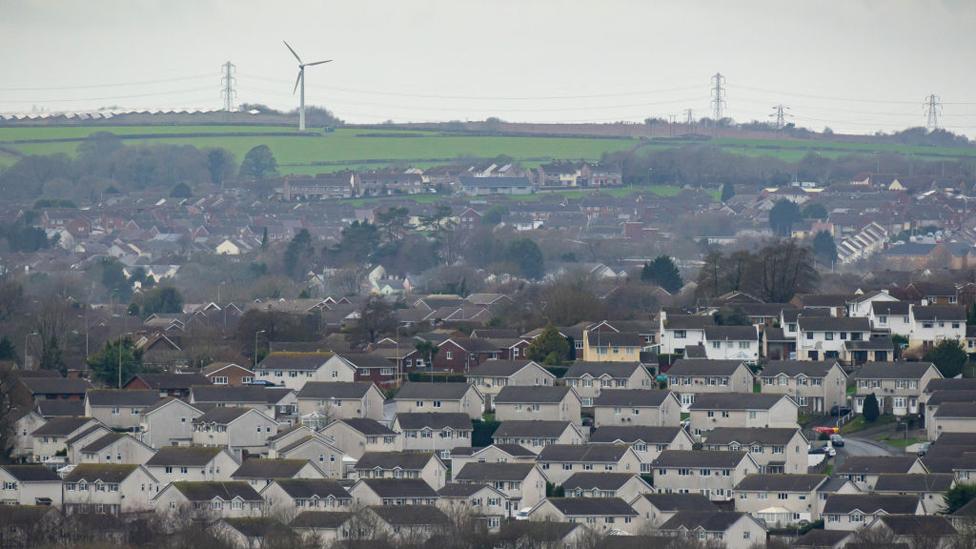
Bridgend county has a population of 140,000 - predicted to grow to 150,000 by 2030. The main urban town has a 47,000 population.
Alex Kilby, partner in Devonald solicitors, which itself expanded into Bridgend 18 months ago, said there is still a lot of demand for housing from growing families perhaps on their second or third rung of the housing ladder.
"They don't want to live in the city any more, they've got a family but commuting is crucial to them," he said.
"You've got the M4 right next door so Bridgend is perfect for them. Out of Cardiff you get a lot more for your money and the new developments are being snapped up quickly."
"The M4 is a double-edged sword in that people want to come and live in Bridgend but it's so easy to go along the M4 to Cardiff to shop."
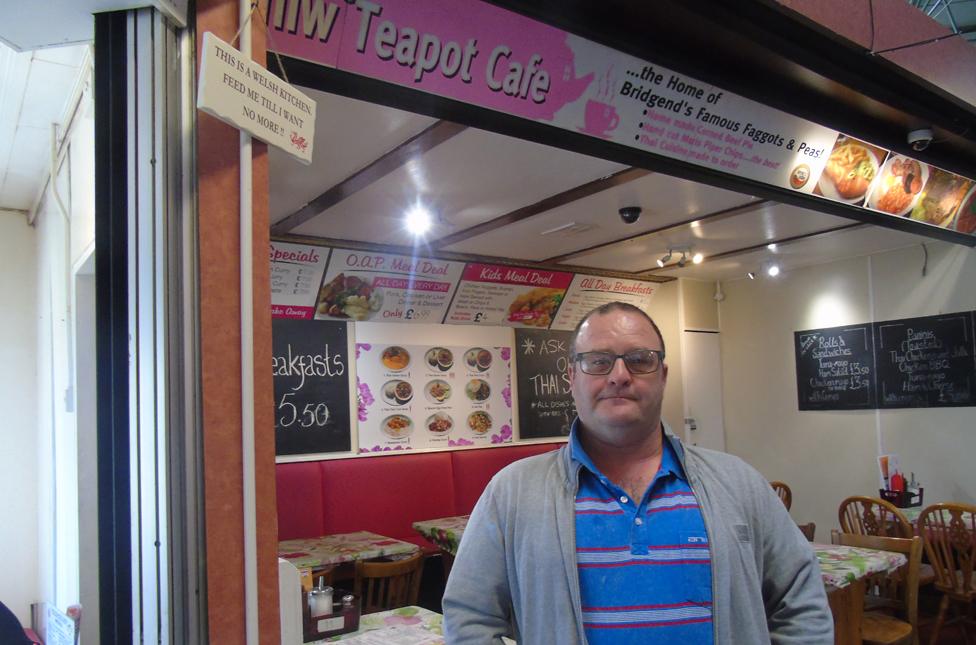
Darren Hamm, who has opened a second cafe in the indoor market
There are signs of positivity at the indoor market - which reduced rents to new traders as part of a revamp and to stop a decline. Vacancy rates have dropped from 40% to 15% - the lowest level in three years.
"Business is good and on the up," said Darren Hamm, who has two cafes there.
"We're getting a toilet in the market next year - which we need - and I started the ball rolling on that."
"There are events going on, all that brings new people in - you see different faces. People say 'Bridgend's dead' but there's no changing some people. But we've had people coming into the market who've not been here for three or five years."
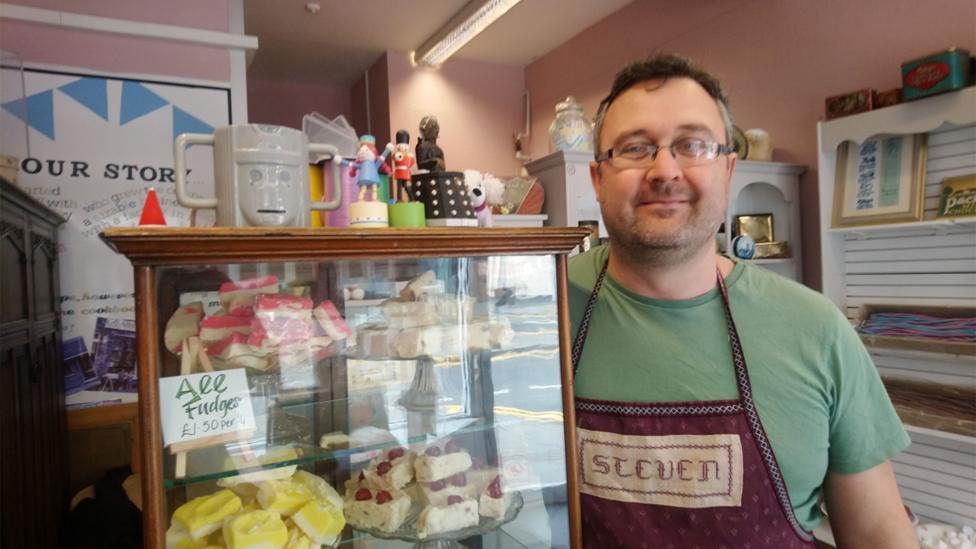
Steven Bletsoe - toffee maker and deputy town mayor - believes Bridgend needs to aim higher
Steve Bletsoe, with wife Freya, runs a traditional sweet shop Ella Riley's in Nolton Street.
The couple also make fudge and traditional toffee - Riley's Toffee Rolls - which sells across the world, including to the United States, Australia and the New Zealand.
Steve, who is also an independent town councillor and deputy mayor, believes Bridgend needs to more ambitious "and be a good as it can be".
"We lived in Wakefield which was a town which thought it was a city, whereas I think Bridgend is a town which thinks it's a village".
He is unhappy that bus subsidies have been recently cut - which has been blamed on austerity and worries this will be a further disincentive to shoppers.
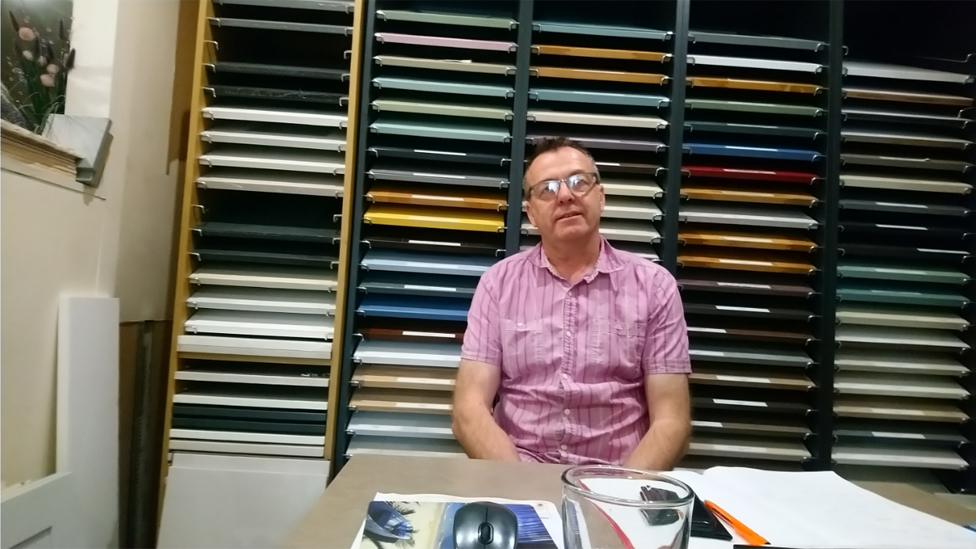
Mike Gibbins sees customers from across south Wales
One person who can see the value of the M4 is Mike Gibbins, whose family-run Kitchen Design Studio has customers from Ammanford to Abergavenny.
"We rely on the M4 corridor for deliveries and fittings," he said.
"We're also quite proud as a small business we're bringing in people into town to the showroom and we've just opened a cafe next door."
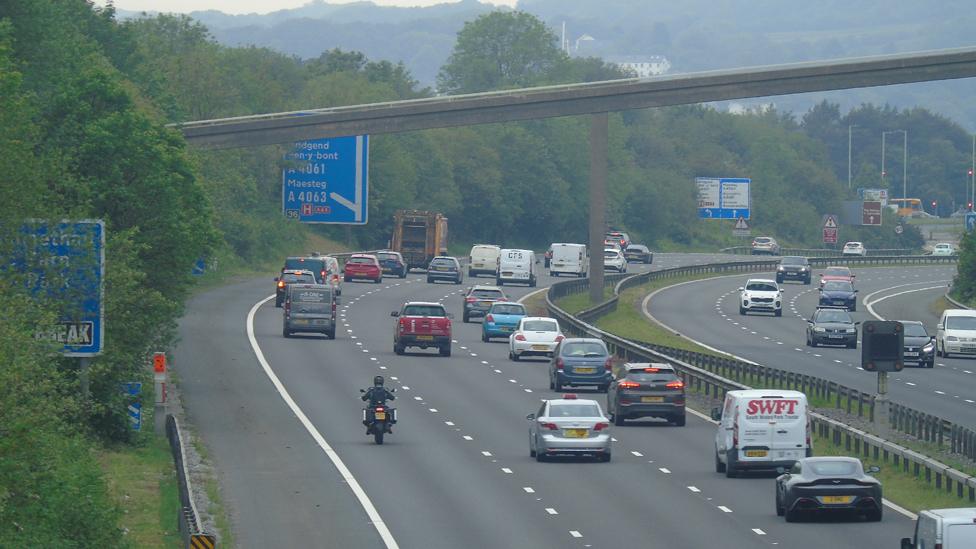
The M4 finally opened around Bridgend in 1981 after a number of delays
The Ford closure will undoubtedly have an impact.
"It's taken me by surprise, I must admit" said CF31's Justin Jenkins.
"It's our biggest employer and it's not just the people who work there and their families but the local businesses which supply it, the little cafes."
Bridgend was already bracing itself for a potentially difficult period - and this will add to worries. But if more of the community's spending power stays within the town, there might be a chance.
"Retail trends tell us to expect a further drop in footfall so we know we have a challenge - and we'll be putting in big efforts," he added.
- Published10 June 2019

- Published12 June 2019
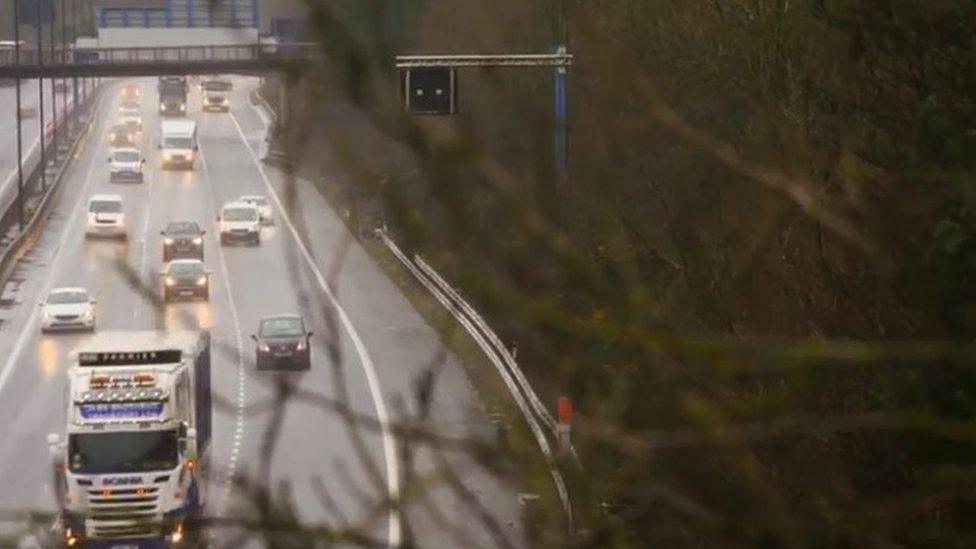
- Published10 June 2019
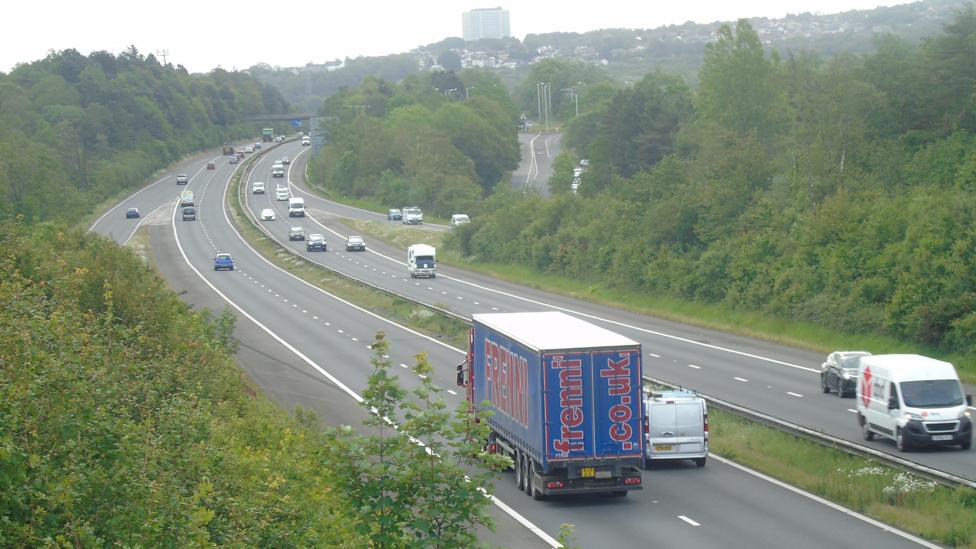
- Published6 June 2019
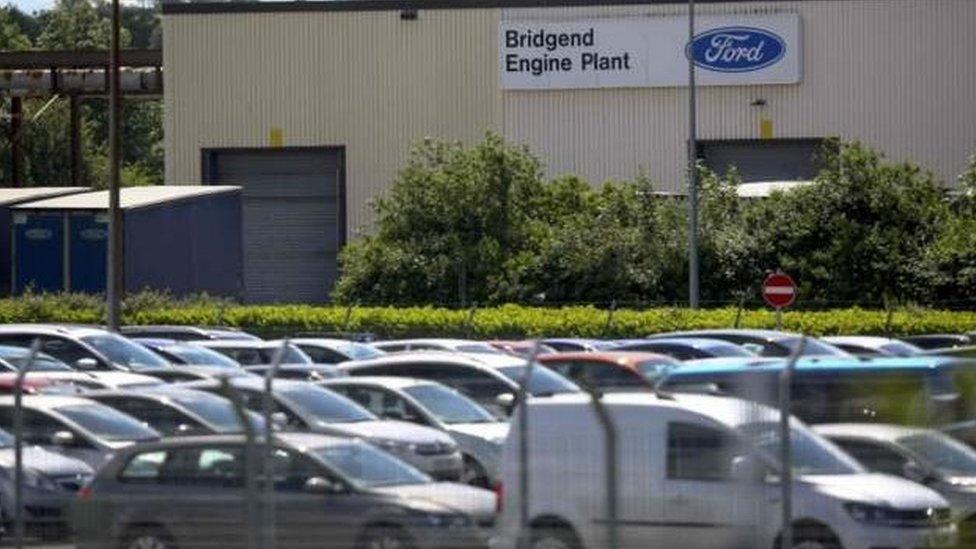
- Published6 June 2019
